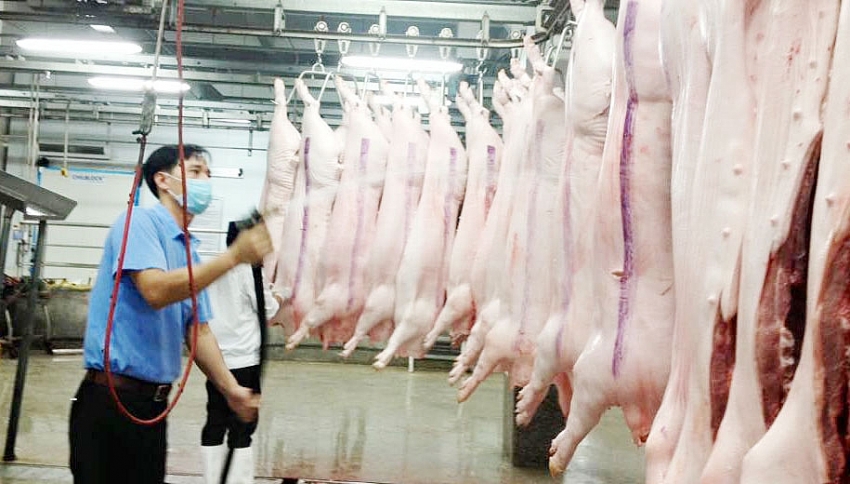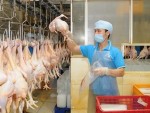The difficulties in reaching Vietnam’s agricultural export target
 |
| Vietnam is considering boosting pork exports |
Impressive performance across the board
In 2017, the export of agricultural products marked new records, such as fishery exceeded and forestry products hit $8 billion, and fruits and vegetables broke the record of $3.45 billion by increasing 40.5 per cent compared to 2016.
China, Japan, the US, and South Korea were the four leading markets importing Vietnamese fruits and vegetables, with market proportions of 75.7, 3.7, 2.9, and 2.5 per cent, respectively. Besides, the quality of Vietnamese fruits has gradually been confirmed, and the products conquered such hard markets like the US, the EU, Japan, Canada, Australia, and New Zealand.
Cashew nut exports hit 353,000 tonnes and $3.52 billion in 2017, up 1.9 per cent in volume and 23.8 per cent in value. The US, the Netherlands, and China remained the three biggest importers with 35, 15.6, and 12.9 per cent of Vietnam’s exports, respectively.
About 3.4 million tonnes of cashew materials were harvested throughout the year, 1.6-1.7 million tonnes of which has been processed in Vietnam.
Forestry exports were estimated at $8 billion, up 9.1 per cent on-year. The US, China, and Japan are the three leading import markets, taking up 42.8, 14, and 13.5 per cent of the total, respectively.
In 2017, the exports of agricultural products such as rice, coffee, rubber, and tea recovered but did not hit the earlier record. Rice exports reached 5.89 million tonnes and gained $2.66 billion, up 22.4 per cent in volume and 23.2 per cent in value on-year. 1.39 million tones of rubber have been exported throughout the year, fetching $2.26 billion, up 11 per cent in volume and 35.6 per cent in value.
Pork and seafood in the red
Of Vietnam’s major agricultural sectors, husbandry is the weakest export sector. The output of pork was estimated at 2.75 million tonnes in 2017, ranking sixth over the world. However, almost all live-weight pigs were exported to China through unofficial channels. Unofficial exports of live-weight pigs to China reached 12 million animals in 2016 (equivalent to 33,000 ones daily).
In 2017, live-weight pig exports to China have been cancelled and pig farming went into the red as supply exceeded demand. As a result, farmers have been reporting losses during the past year and a half.
Official exports of live-weight pig hit 19,475 tonnes in 2017 and fetched $78.38 million, down 54 per cent in volume and 22.7 per cent in value on-year.
Fisheries also slipped into the red after the EU gave a “yellow card” for Vietnamese fishery products on October 23, 2017 due to not meeting requirements on illegal unregistered and unregulated (IUU) fishing.
Vietnam’s seafood exports to the EU have recovered since then, but the time period of checking product traceability has been raised, leading to increased storage time and checking fees for Vietnamese firms. This also made importers in various markets anxious about Vietnamese fishery products.
Targeting $40 billion this year
Since the beginning of the year, a multitude of issues in agriculture and rural development arose. Firstly, it was imperative to remove the “yellow card” for seafood exports to the EU. Thereby, Vietnam has to perfect its institutions to manage fishing fleets and increase the inspection of fishing vessels on sea and at ports, as well as confirm the origin of aquatic goods and put a stop to the illegal exploitation of foreign waters.
The newly approved Law on Fisheries (2017) needs to be enforced effectively to ensure fishing activities are in line with EU and global regulations. Relevant ministries and agencies should collaborate and do their utmost to remove the yellow card.
Breaking open the pork exporting market is one of the major tasks set forth by the Ministry of Agriculture and Rural Development (MARD). Following the first batch of Vietnamese chickens exported to Japan in last September, MARD and husbandry companies have set their eyes on exporting Vietnamese pork to the world.
Gabor Fluit, director general of De Heus Group Asia, said: “After the success of exporting chickens to Japan, De Heus and partners will try to export pork to China, Japan, and South Korea.”
According to MARD, the export value of fruits and vegetables was estimated at $321 million in the first month of 2018, up 36.9 per cent on-year. This is a spectacular performance and a foundation to actualise the goal of $40 billion of agricultural exports in this year.
At the conference summing up agricultural and rural development in 2017, Prime Minister Nguyen Xuan Phuc set the goal of $40 billion for agriculture, forestry, and fishery exports. The common view is that as long as the country manages to pump out the necessary solutions to remove disadvantages and seizes the opportunities present, this goal is absolutely possible.
 | Export goods spotlights 2017 Vietnam's agricultural, forestry, and fisheries (AFF) exports have seen spectacular performance in certain product categories and markets, such as processed chicken exported to Japan or dragon ... |
 | Company to build factory to increase chicken exports The Koyu & Unitek Company, based in the southern province of Dong Nai, plans to develop a second chicken processing factory to meet the demand ... |
 | Vietnam poultry sector calls for dumping investigation into US chicken imports Two Vietnamese husbandry associations are appealing to the government to launch a probe to determine whether U.S. businesses are dumping their chicken products at below-market ... |
What the stars mean:
★ Poor ★ ★ Promising ★★★ Good ★★★★ Very good ★★★★★ Exceptional
Related Contents
Latest News
More News
- Businesses ramp up production as year-end orders surge (December 30, 2025 | 10:05)
- Vietjet chairwoman awarded Labour Hero title (December 29, 2025 | 13:06)
- How to unlock ESG value through green innovation (December 29, 2025 | 10:03)
- AI reshapes media and advertising industry (December 29, 2025 | 08:33)
- FPT and GELEX sign deal to develop blockchain tech for global markets (December 29, 2025 | 08:29)
- Vietnam’s GDP forecast to grow by 9 per cent in 2026 (December 29, 2025 | 08:29)
- Women entrepreneurs are key to Vietnam’s economic growth (December 29, 2025 | 08:00)
- Vietnam's top 500 value-creating enterprises announced (December 27, 2025 | 08:00)
- The PAN Group shaping a better future with ESG strategy (December 26, 2025 | 09:00)
- Masan Consumer officially lists on HSX, marking the next phase of value creation (December 25, 2025 | 13:20)

 Tag:
Tag:





















 Mobile Version
Mobile Version